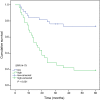Clinical significance of long noncoding RNA SPRY4-IT1 in melanoma patients
- PMID: 27239436
- PMCID: PMC4821346
- DOI: 10.1002/2211-5463.12030
Clinical significance of long noncoding RNA SPRY4-IT1 in melanoma patients
Abstract
Long noncoding RNA SPRY4-IT1 has been reported to promote melanoma cell growth and invasion, and to block apoptosis. The purpose of this study was to investigate the clinical significance of SPRY4-IT1 in patients with malignant melanoma. The relative expression levels of SPRY4-IT1 were measured in plasma samples from 70 patients and 79 healthy controls by quantitative reverse transcriptase polymerase chain reaction. SPRY4-IT1 expression is high in melanoma patients but low in healthy controls, and is closely associated with tumor site and tumor stage. Elevated SPRY4-IT1 significantly reduces overall survival rates of patients and is considered as an independent prognostic factor in patients with melanoma. The prognostic nomogram shows a good prediction of the probability of 5-year overall survival of patients with melanoma (c-index: 0.72). The calibration curve for the probability of survival presents good agreement between actual outcomes and predictive consequences. In summary, SPRY4-IT1 may be a potential prognostic marker and a potential therapeutic target.
Keywords: SPRY4‐IT1; long noncoding RNA; melanoma; overall survival.
Figures




Similar articles
-
Prognostic Value of Long Noncoding RNA SPRY4-IT1 on Survival Outcomes in Human Carcinomas: A Systematic Review and Meta-Analysis with TCGA Database.Biomed Res Int. 2020 Nov 1;2020:5868602. doi: 10.1155/2020/5868602. eCollection 2020. Biomed Res Int. 2020. PMID: 33204703 Free PMC article.
-
Upregulation of long noncoding RNA SPRY4-IT1 correlates with tumor progression and poor prognosis in cervical cancer.FEBS Open Bio. 2016 Aug 9;6(9):954-60. doi: 10.1002/2211-5463.12102. eCollection 2016 Sep. FEBS Open Bio. 2016. PMID: 27642559 Free PMC article.
-
The melanoma-upregulated long noncoding RNA SPRY4-IT1 modulates apoptosis and invasion.Cancer Res. 2011 Jun 1;71(11):3852-62. doi: 10.1158/0008-5472.CAN-10-4460. Epub 2011 May 10. Cancer Res. 2011. PMID: 21558391
-
The functional characterization of long noncoding RNA SPRY4-IT1 in human melanoma cells.Oncotarget. 2014 Oct 15;5(19):8959-69. doi: 10.18632/oncotarget.1863. Oncotarget. 2014. PMID: 25344859 Free PMC article.
-
The long non-coding RNA SPRY4-IT1: An emerging player in tumorigenesis and osteosarcoma.Cell Prolif. 2018 Aug;51(4):e12446. doi: 10.1111/cpr.12446. Epub 2018 Feb 27. Cell Prolif. 2018. PMID: 29484753 Free PMC article. Review.
Cited by
-
Prognostic Value of Long Noncoding RNA SPRY4-IT1 on Survival Outcomes in Human Carcinomas: A Systematic Review and Meta-Analysis with TCGA Database.Biomed Res Int. 2020 Nov 1;2020:5868602. doi: 10.1155/2020/5868602. eCollection 2020. Biomed Res Int. 2020. PMID: 33204703 Free PMC article.
-
The Non-Coding Landscape of Cutaneous Malignant Melanoma: A Possible Route to Efficient Targeted Therapy.Cancers (Basel). 2020 Nov 15;12(11):3378. doi: 10.3390/cancers12113378. Cancers (Basel). 2020. PMID: 33203119 Free PMC article. Review.
-
The Functional Role of Long Non-Coding RNAs in Melanoma.Cancers (Basel). 2021 Sep 28;13(19):4848. doi: 10.3390/cancers13194848. Cancers (Basel). 2021. PMID: 34638331 Free PMC article. Review.
-
Interference from LncRNA SPRY4-IT1 restrains the proliferation, migration, and invasion of melanoma cells through inactivating MAPK pathway by up-regulating miR-22-3p.Int J Clin Exp Pathol. 2019 Feb 1;12(2):477-487. eCollection 2019. Int J Clin Exp Pathol. 2019. PMID: 31933852 Free PMC article.
-
Function and Clinical Implications of Long Non-Coding RNAs in Melanoma.Int J Mol Sci. 2017 Mar 28;18(4):715. doi: 10.3390/ijms18040715. Int J Mol Sci. 2017. PMID: 28350340 Free PMC article. Review.
References
-
- Ferlay J, Shin HR, Bray F, Forman D, Mathers C and Parkin DM (2010) Estimates of worldwide burden of cancer in 2008: GLOBOCAN 2008. Int J Cancer 127, 2893–2917. - PubMed
-
- Marzese DM, Scolyer RA, Huynh JL, Huang SK, Hirose H, Chong KK, Kiyohara E, Wang J, Kawas NP, Donovan NC et al (2014) Epigenome‐wide DNA methylation landscape of melanoma progression to brain metastasis reveals aberrations on homeobox D cluster associated with prognosis. Hum Mol Genet 23, 226–238. - PMC - PubMed
-
- Uzdensky AB, Demyanenko SV and Bibov MY (2013) Signal transduction in human cutaneous melanoma and target drugs. Curr Cancer Drug Targets 13, 843–866. - PubMed
-
- Pho LN and Leachman SA (2010) Genetics of pigmentation and melanoma predisposition. G Ital Dermatol Venereol 145, 37–45. - PubMed
LinkOut - more resources
Full Text Sources
Other Literature Sources
Miscellaneous

